
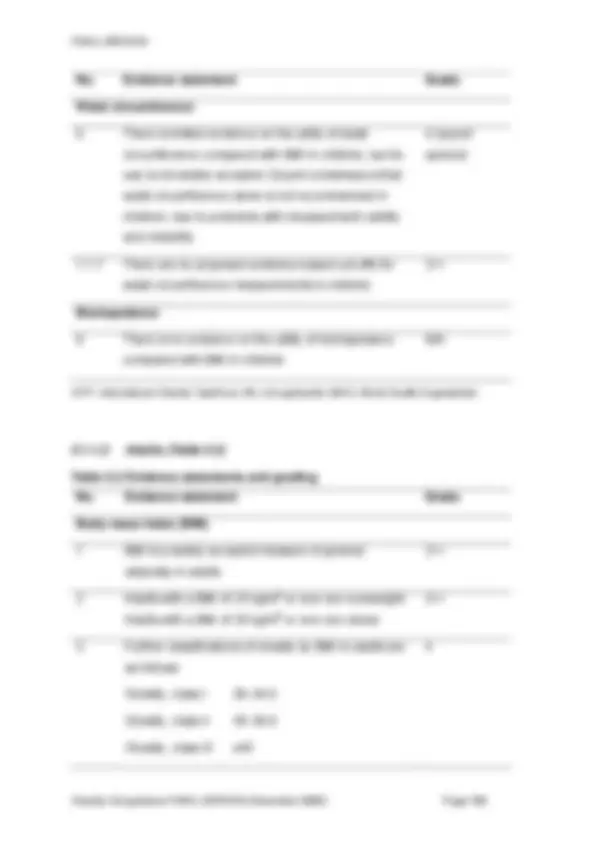
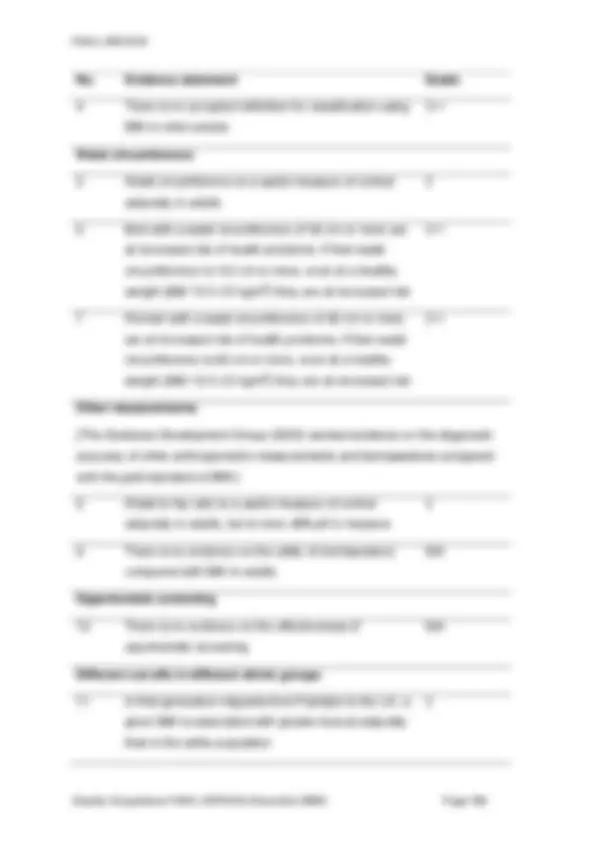
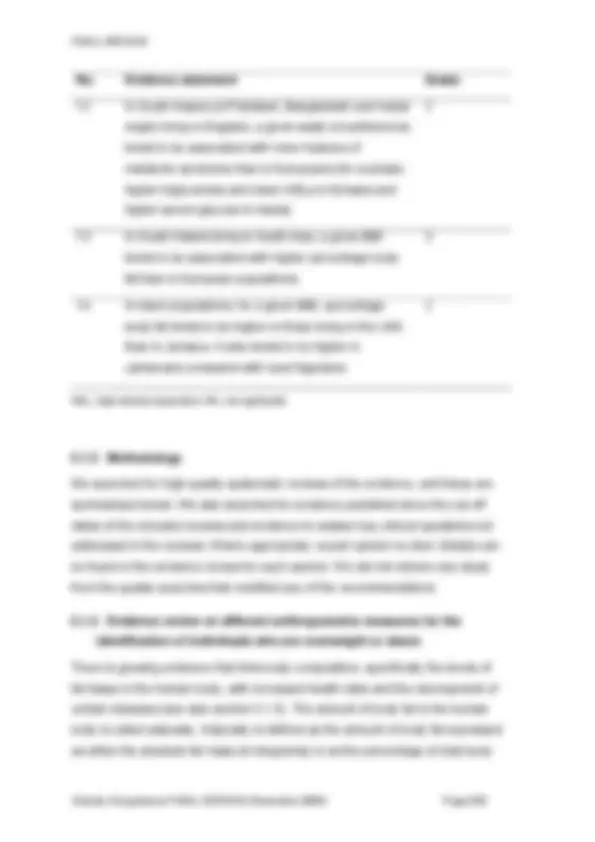
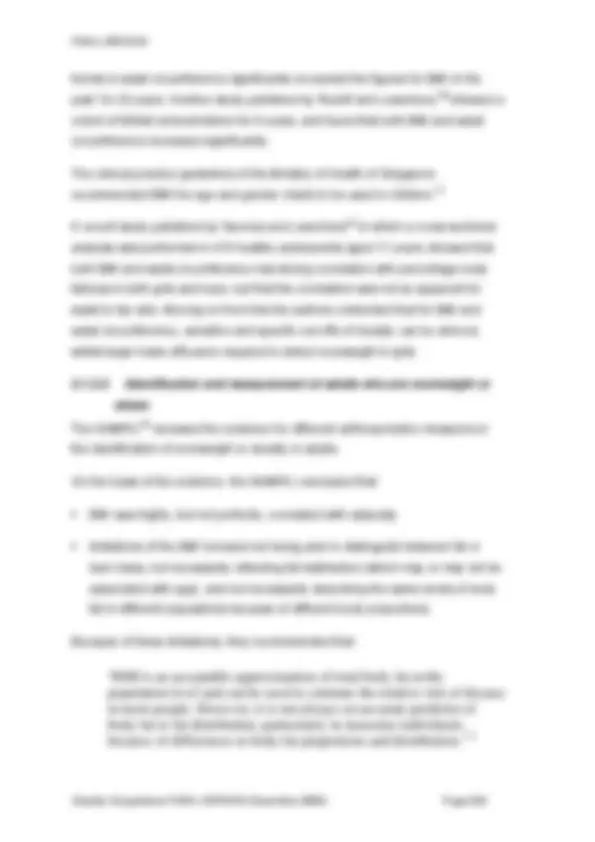
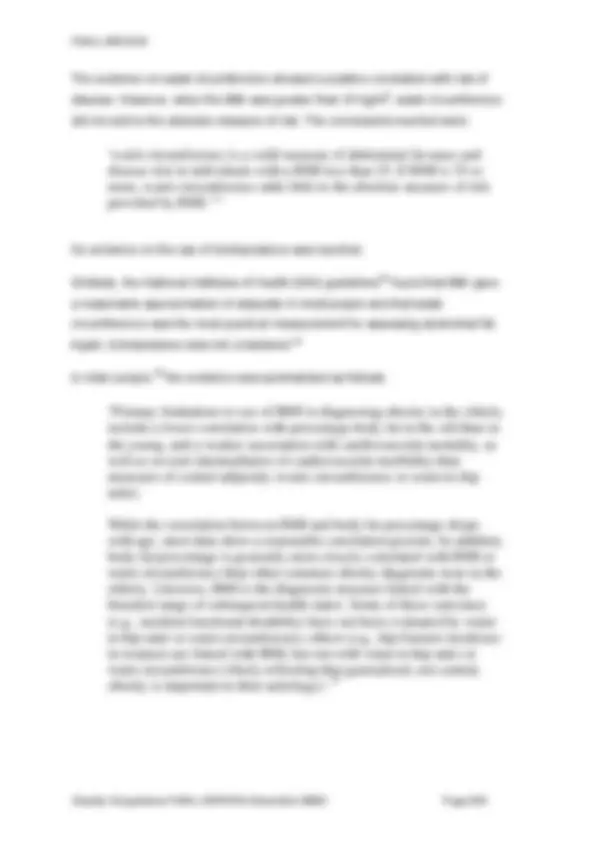
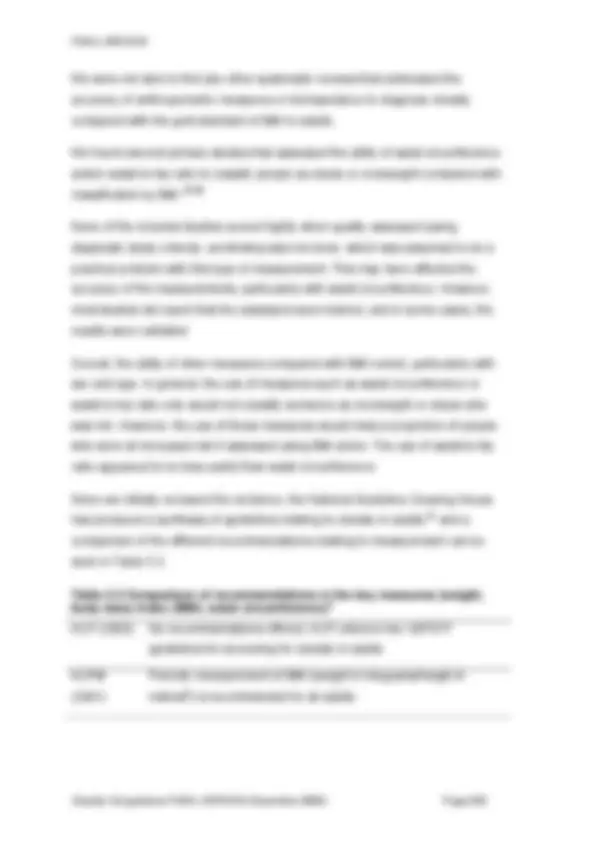
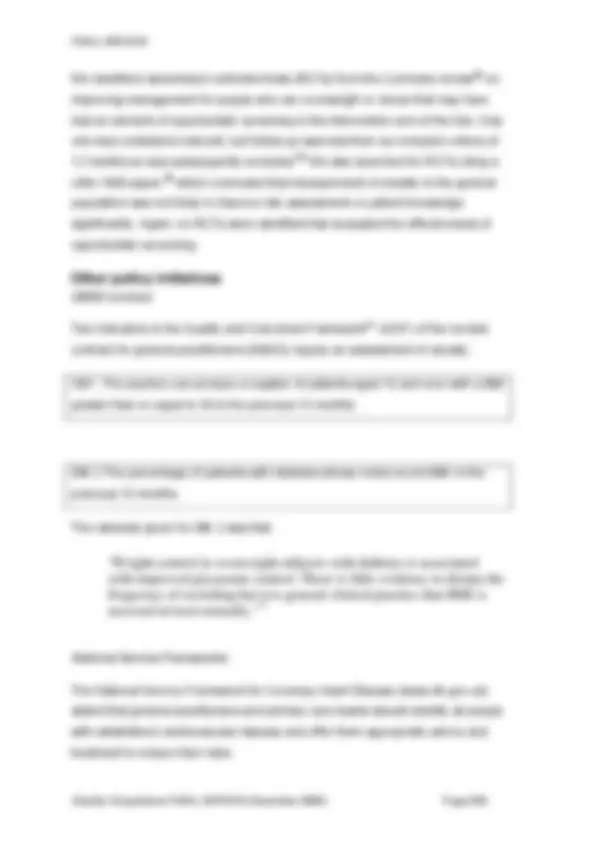
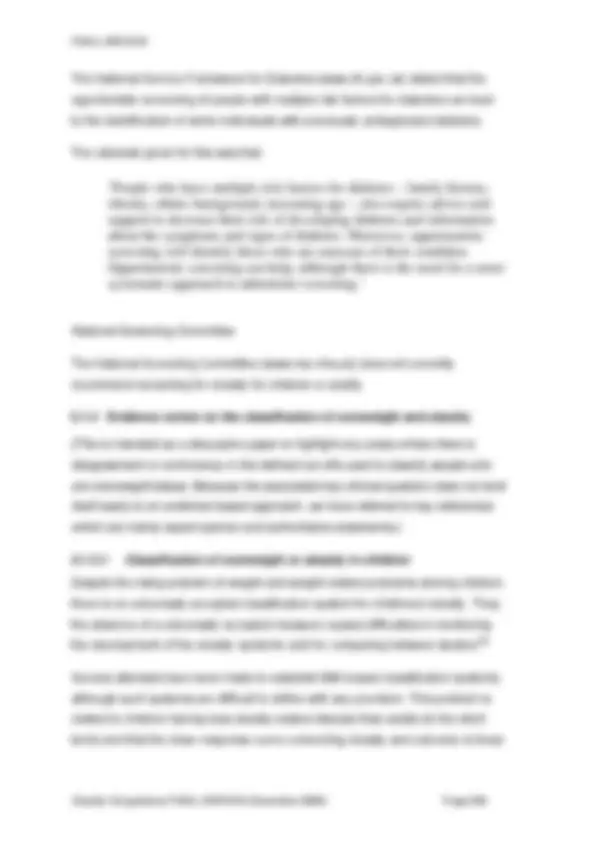
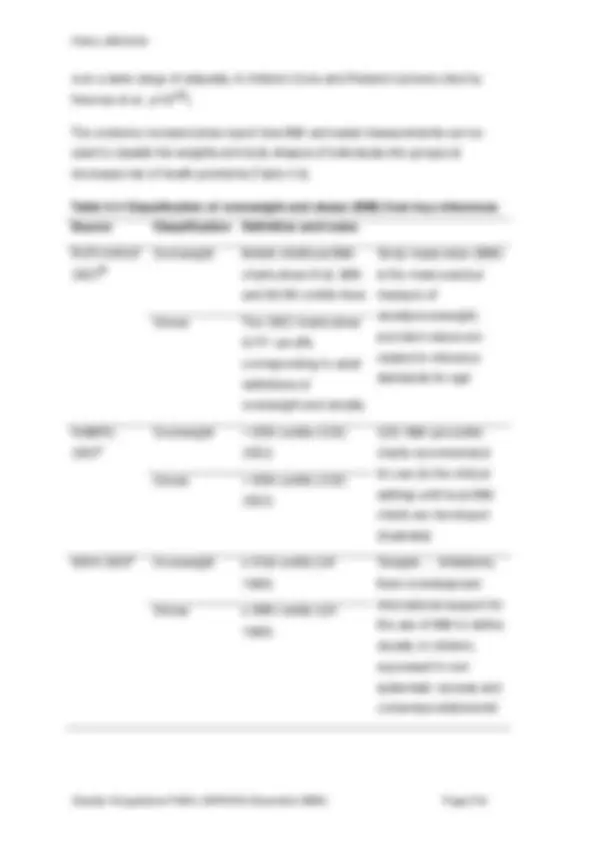
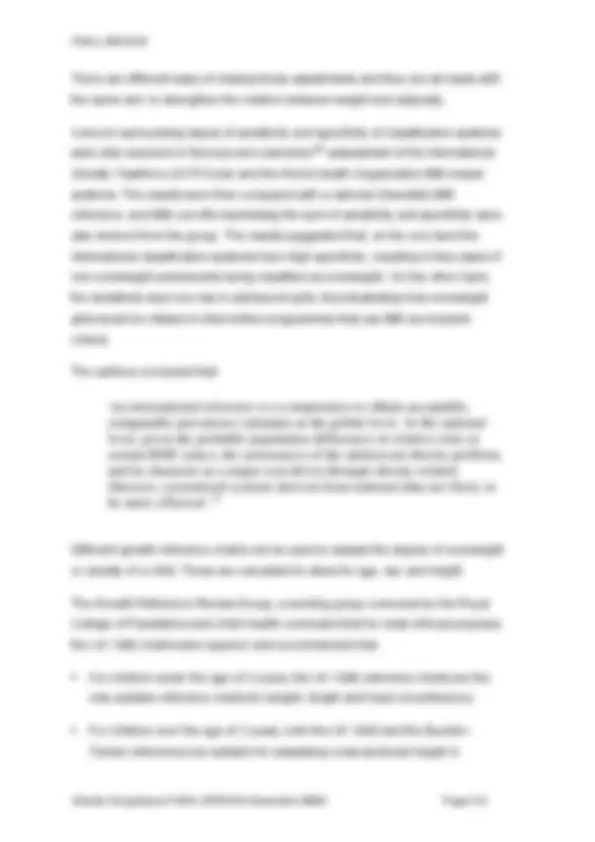
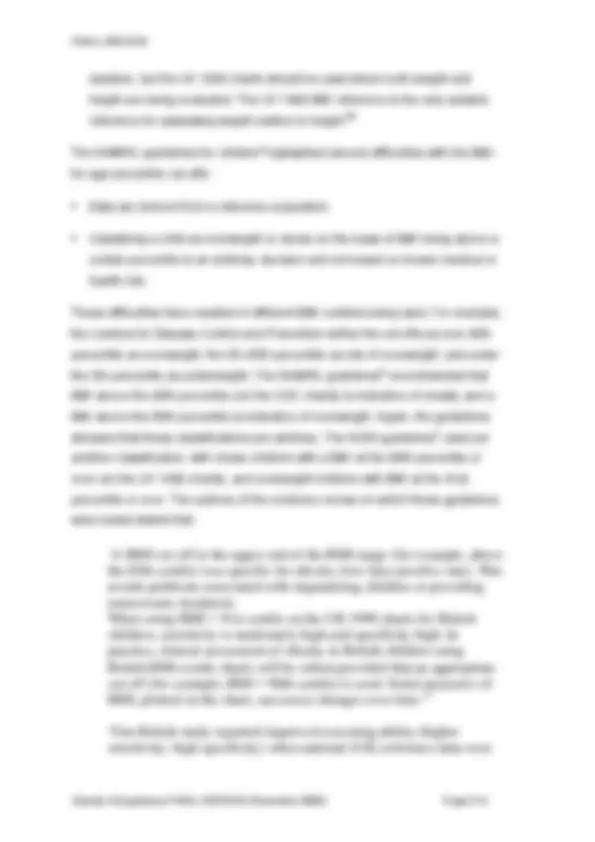
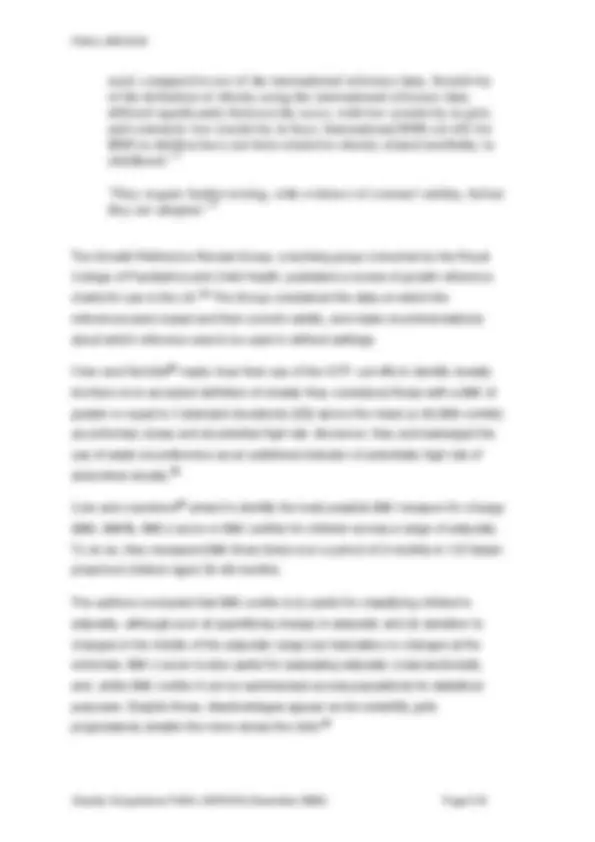
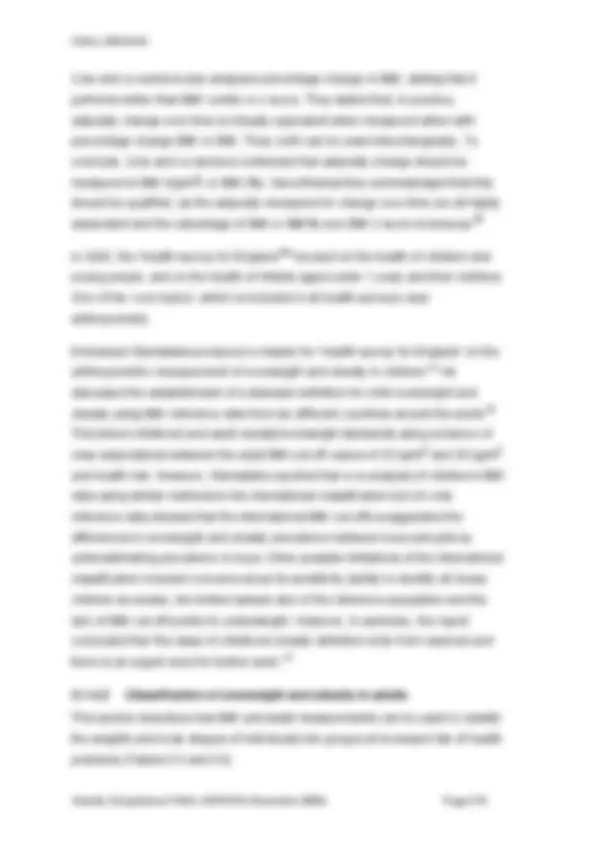
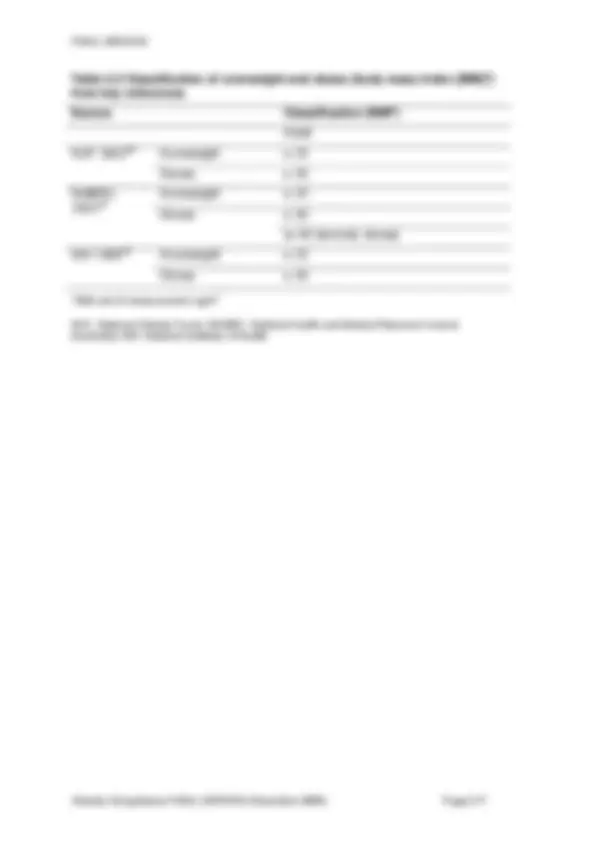
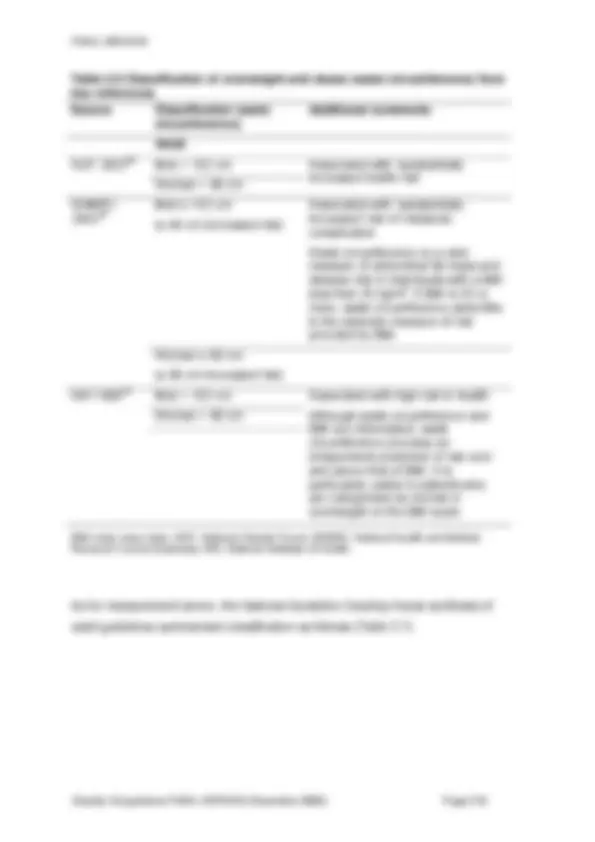
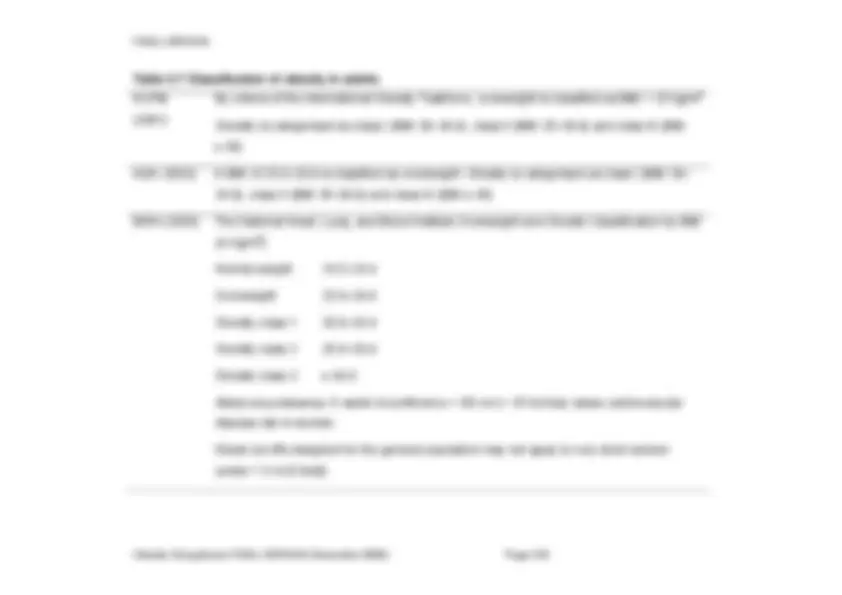
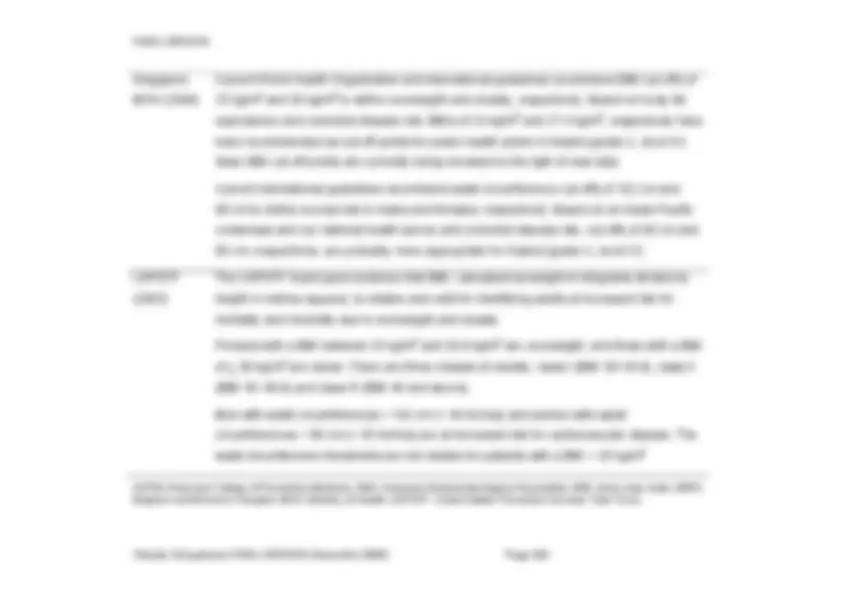
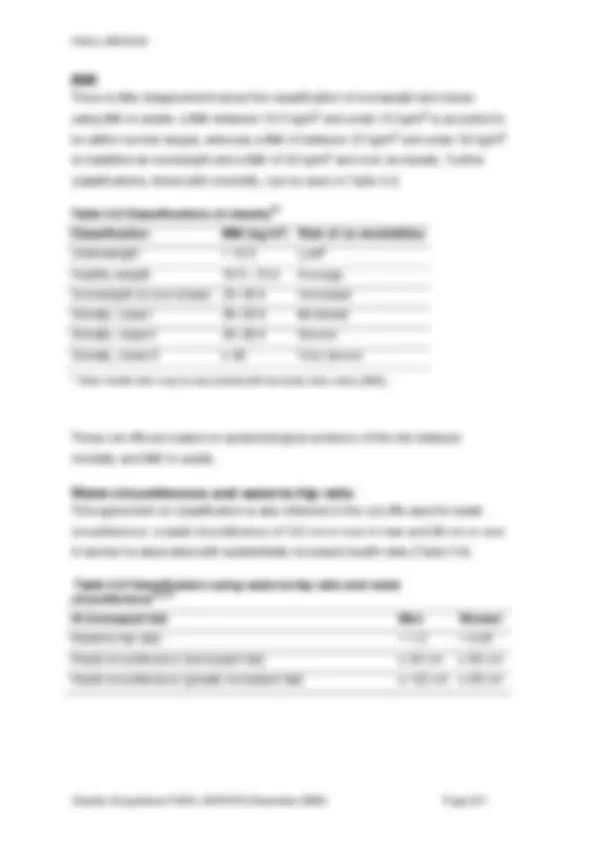
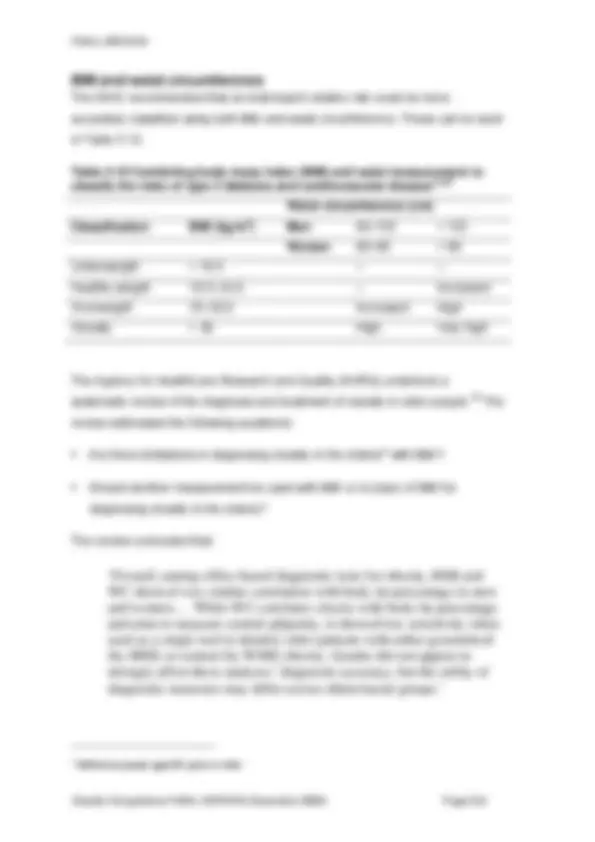
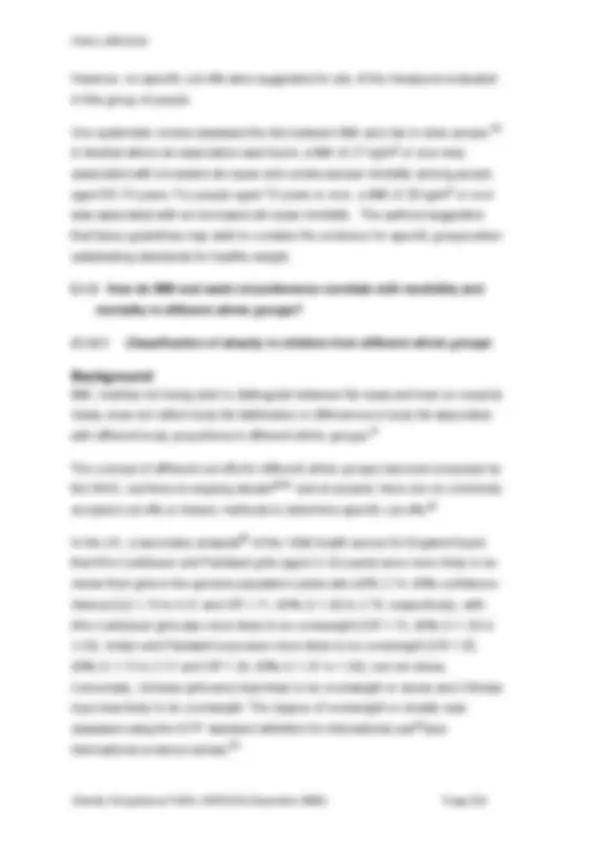
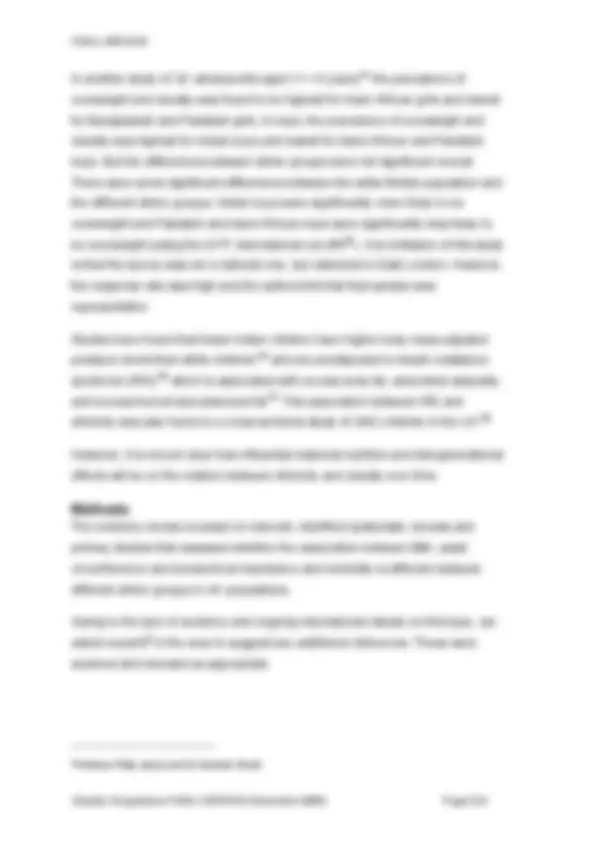
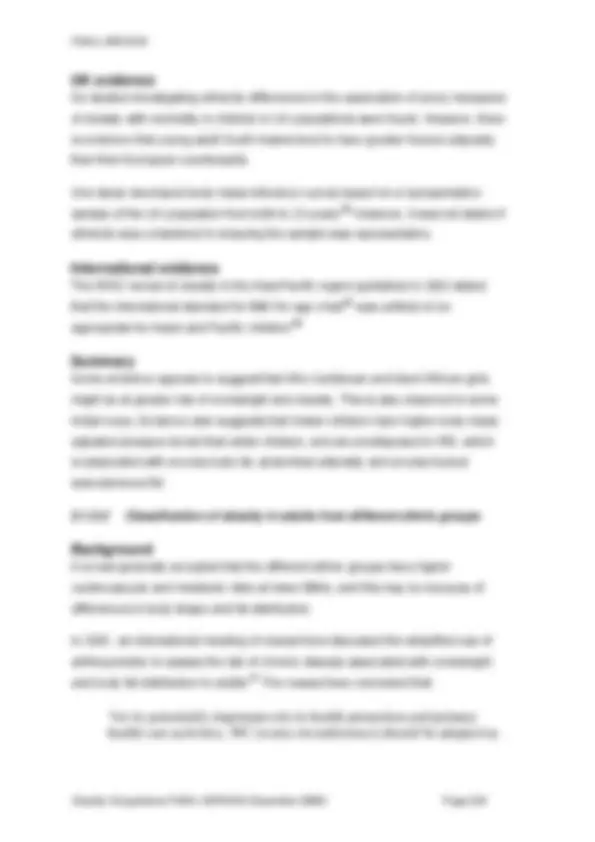
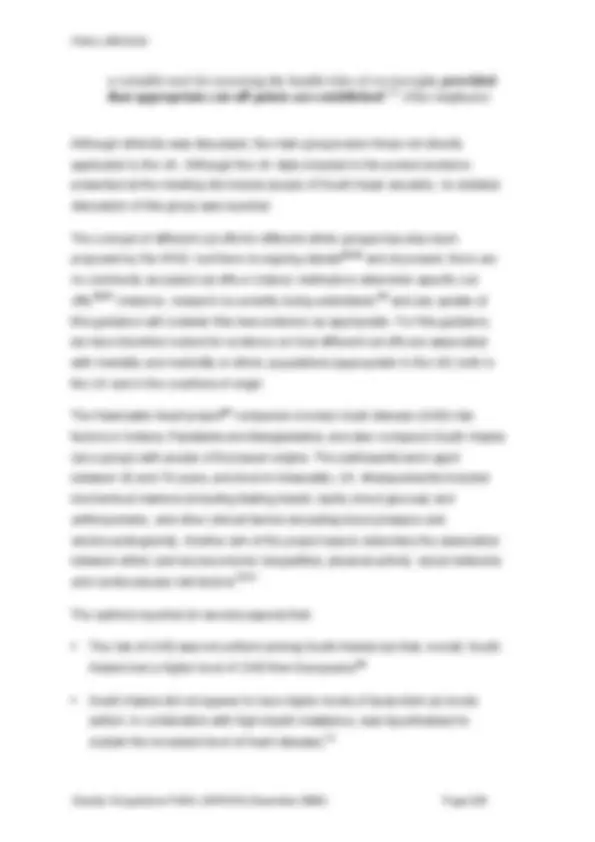
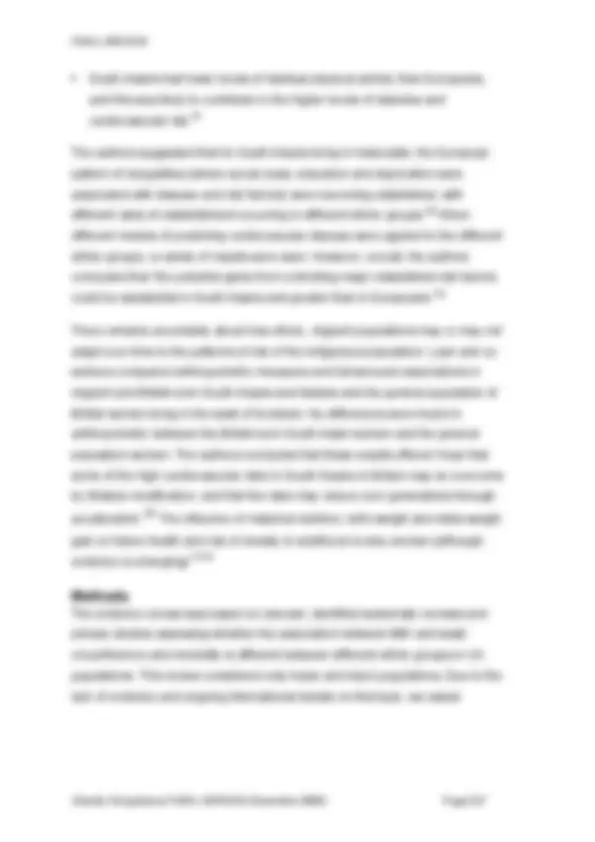
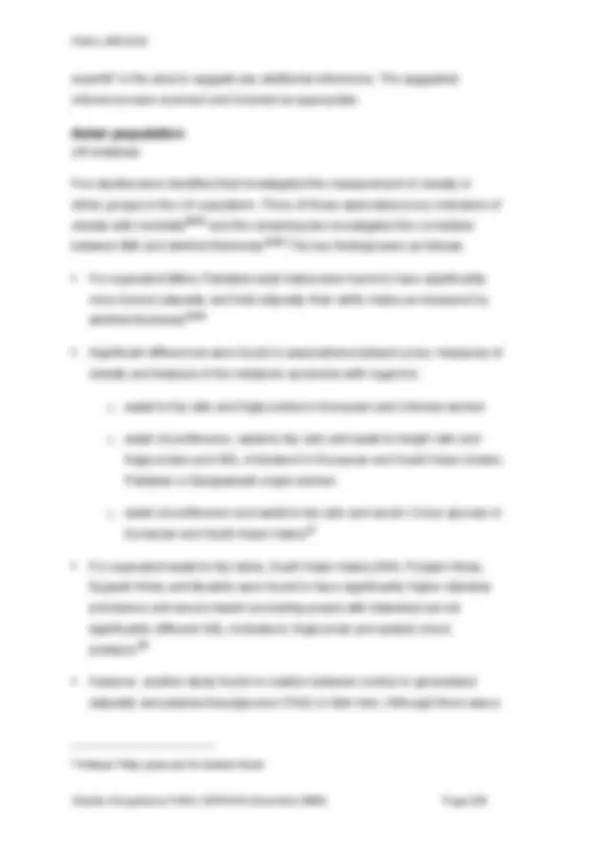

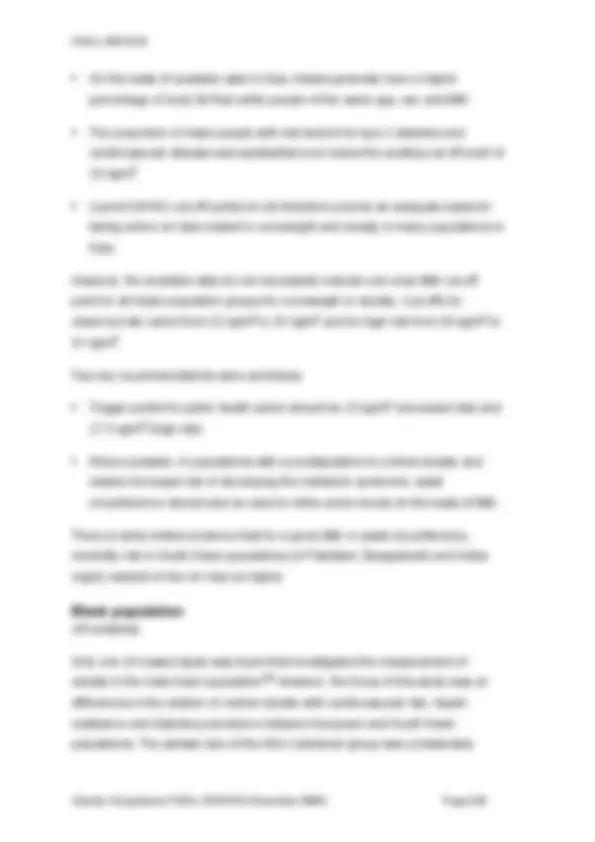
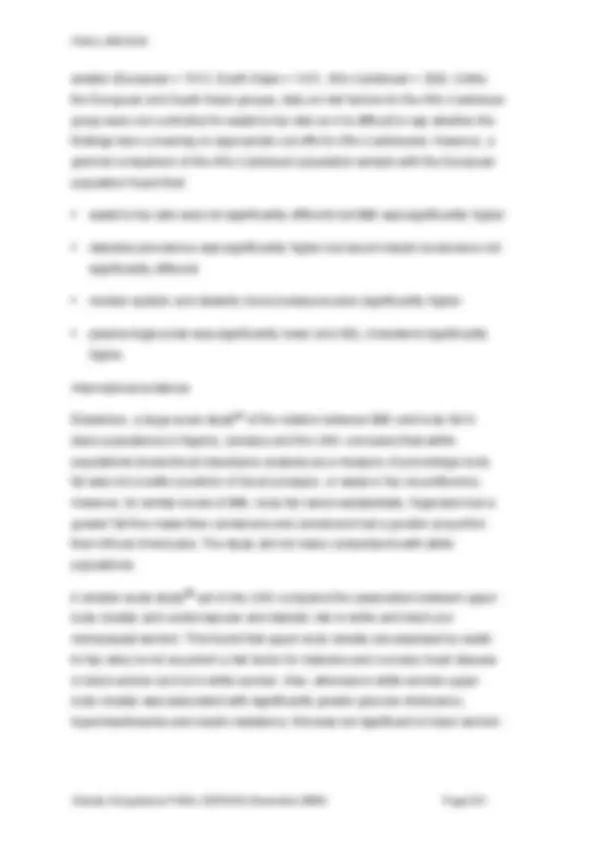
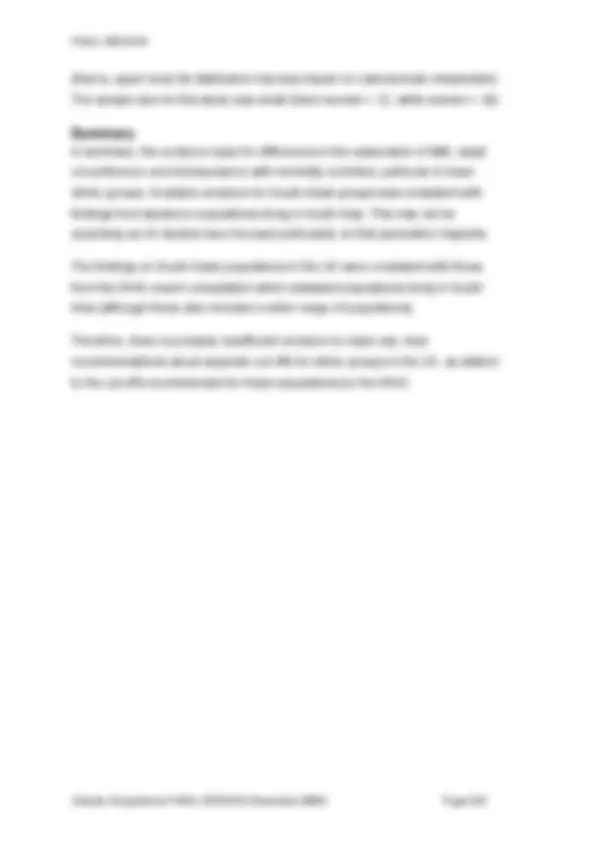
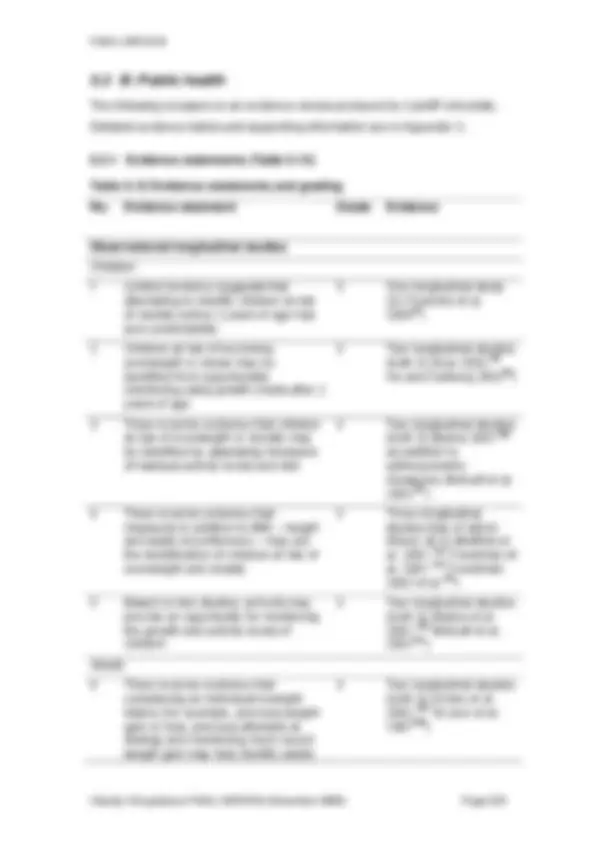
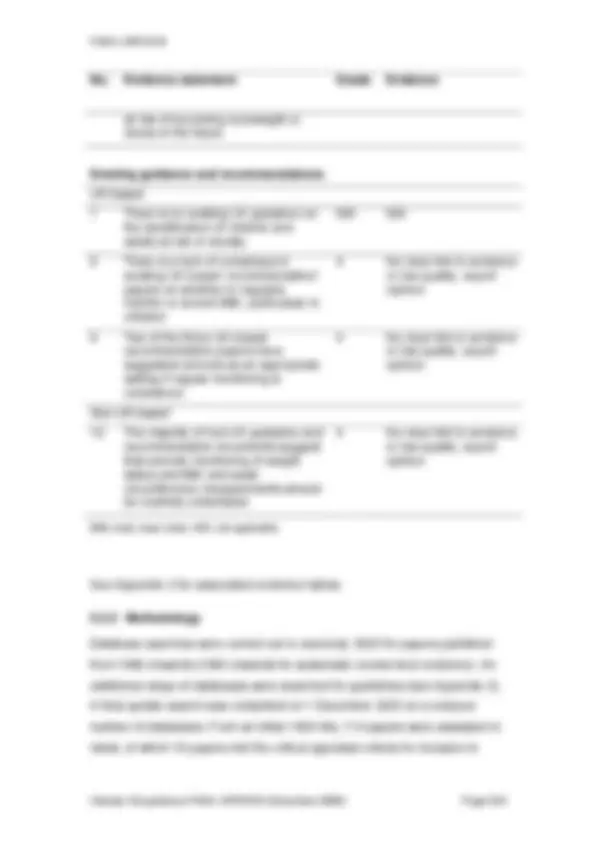
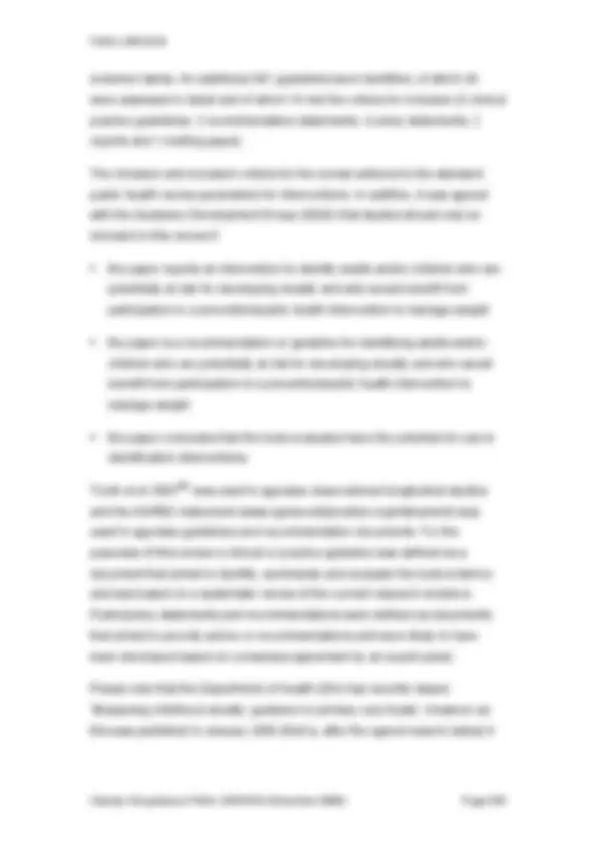
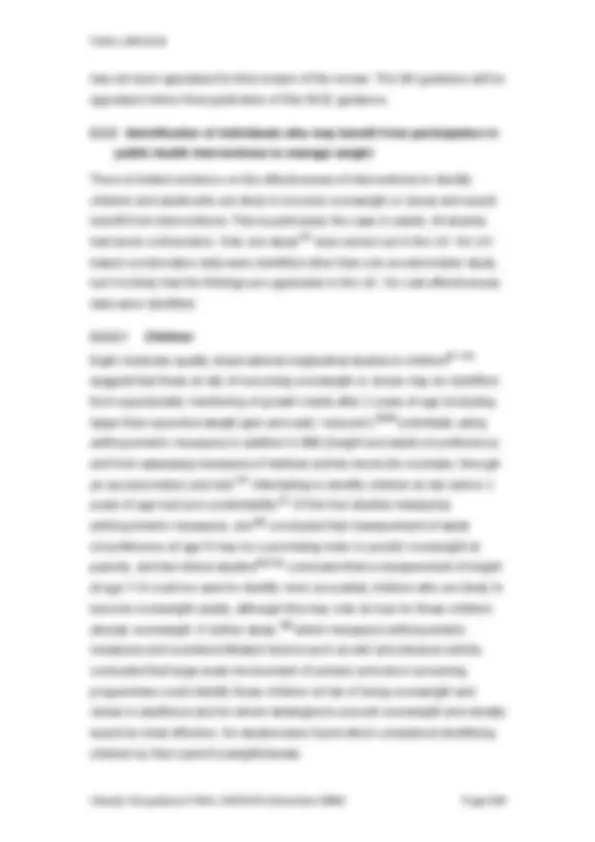
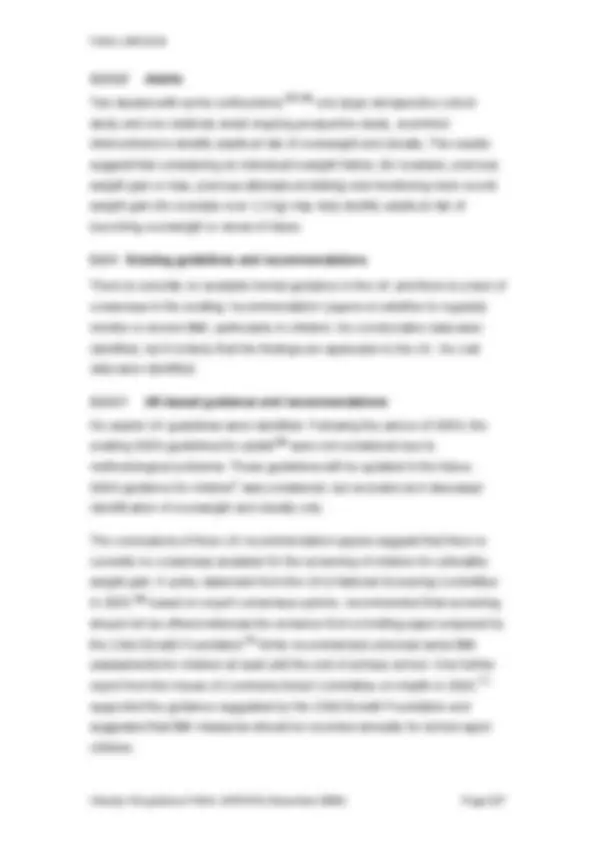
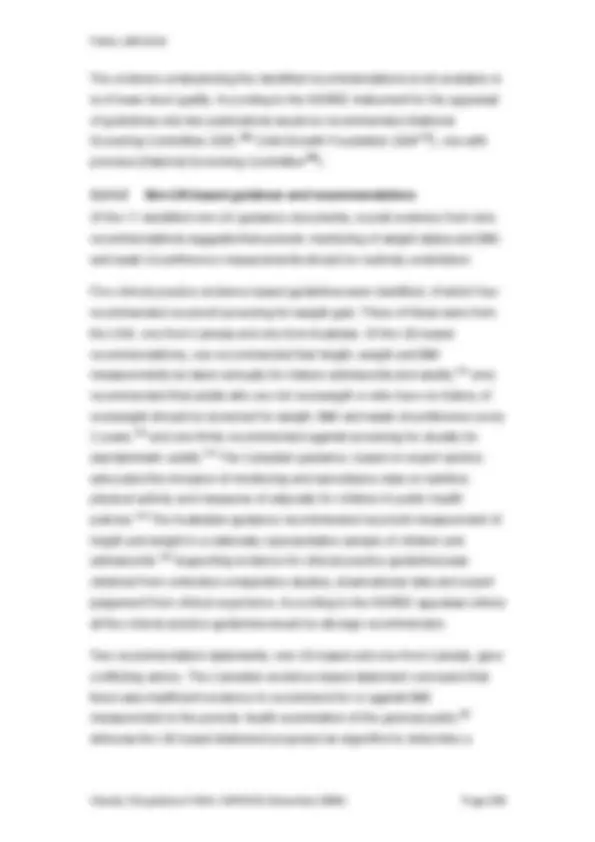
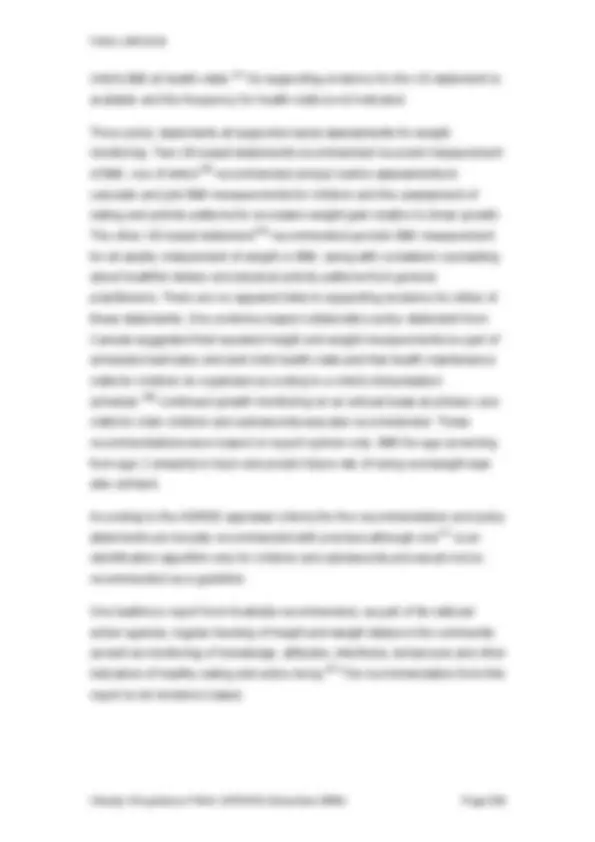
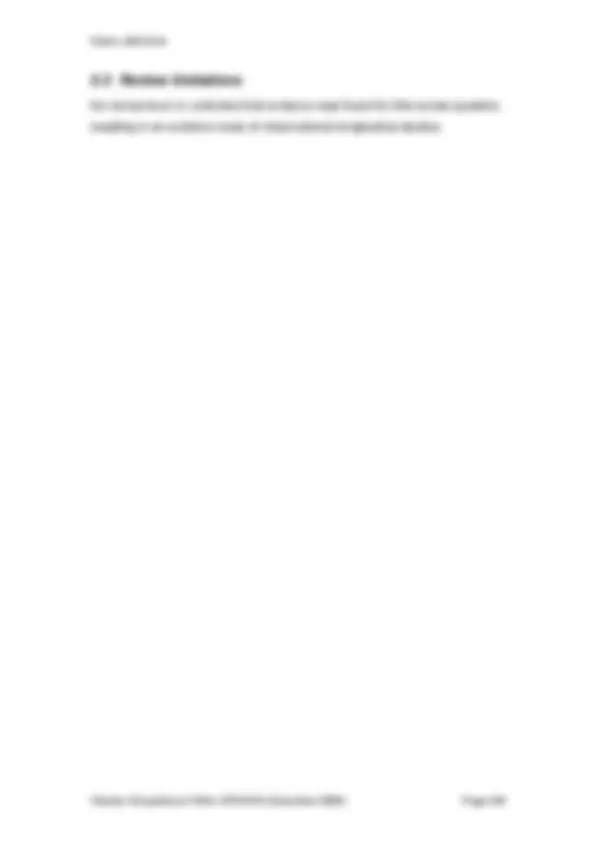
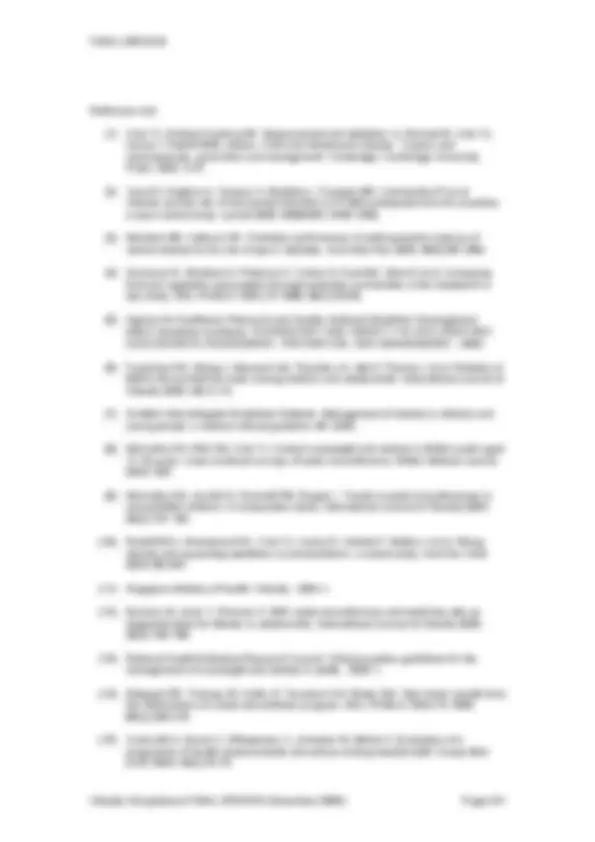

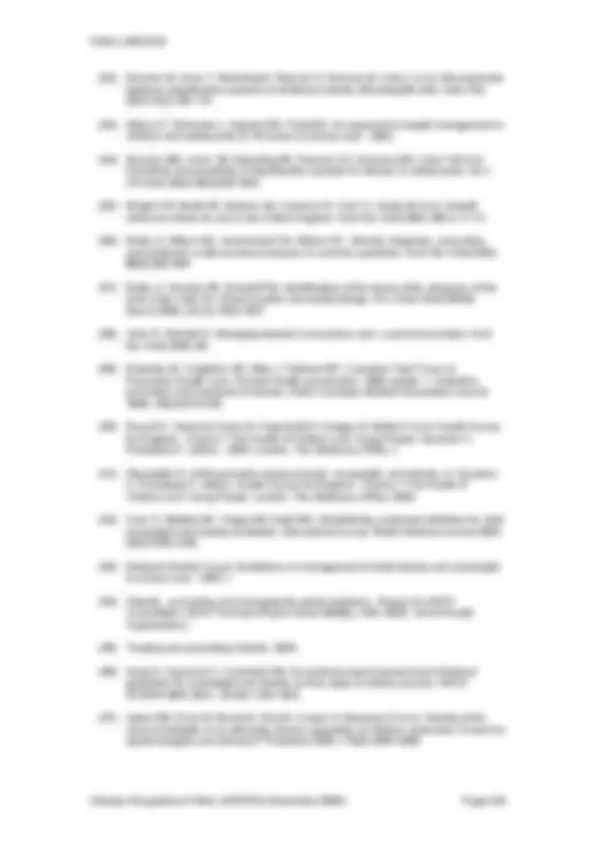
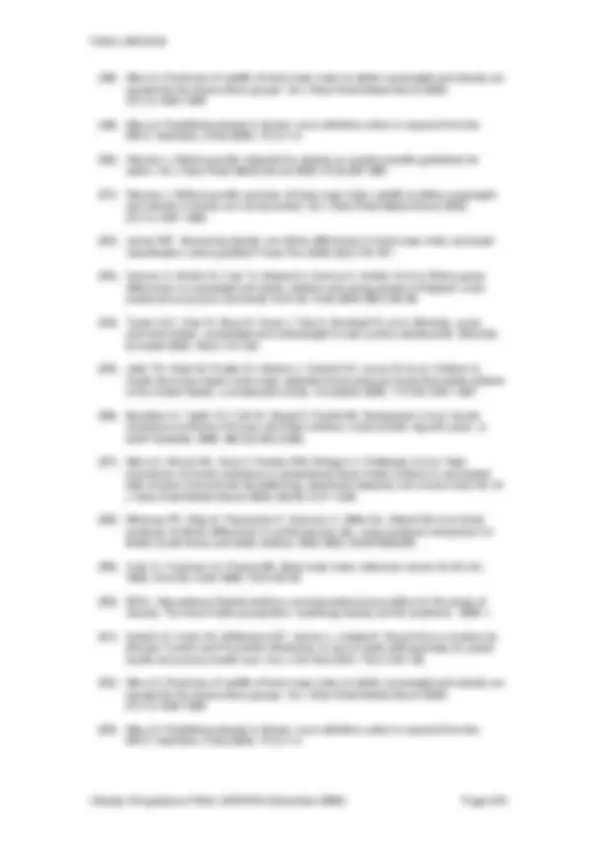
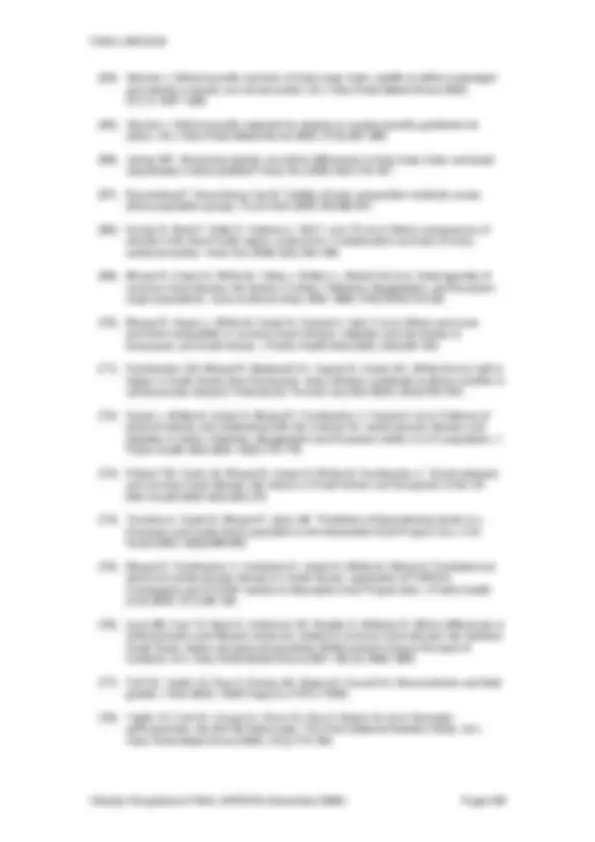
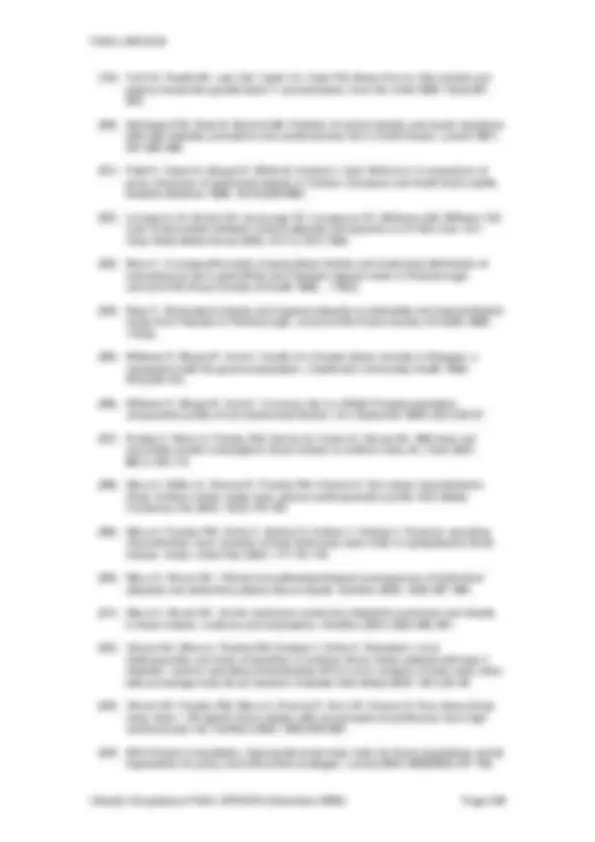
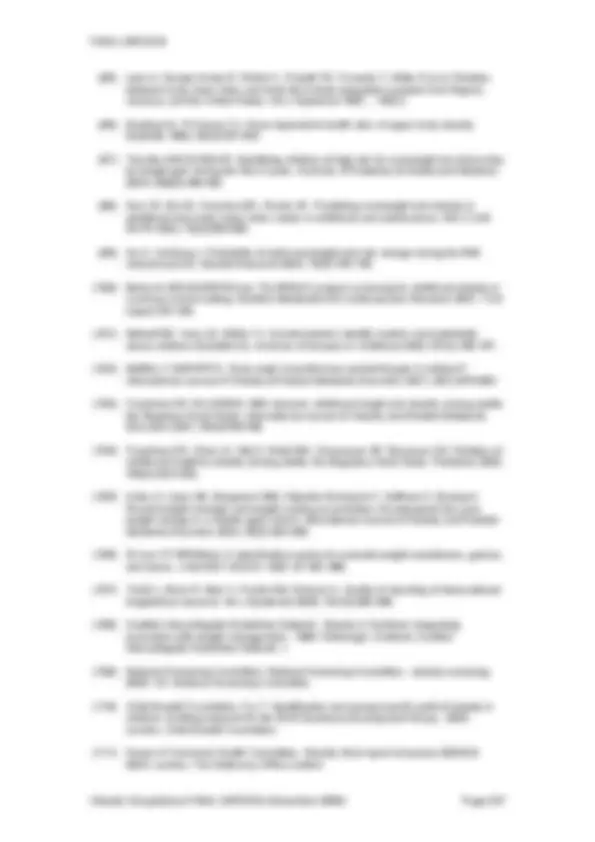
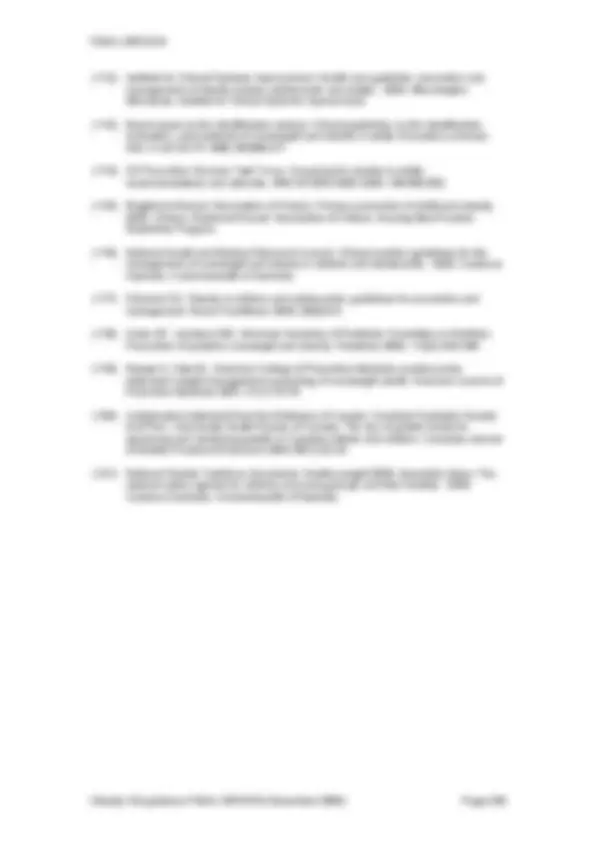


Study with the several resources on Docsity

Earn points by helping other students or get them with a premium plan


Prepare for your exams
Study with the several resources on Docsity

Earn points to download
Earn points by helping other students or get them with a premium plan
Community
Ask the community for help and clear up your study doubts
Discover the best universities in your country according to Docsity users
Free resources
Download our free guides on studying techniques, anxiety management strategies, and thesis advice from Docsity tutors
An evidence-based review of Body Mass Index (BMI) as a measure of adiposity in children, discussing its limitations and alternative measures. It also explores various classification systems for childhood obesity and the role of waist circumference as an additional indicator. The document concludes by highlighting the need for customized systems to address population differences and the importance of regular monitoring.
Typology: Study notes
1 / 53

This page cannot be seen from the preview
Don't miss anything!














































5.1.1 Evidence statements
5.1.1.1 Children (Table 5.1)
Table 5.1 Evidence statements and grading No. Evidence statement Grade Body mass index (BMI) 1 BMI is a widely accepted and practical estimate of general adiposity in children
2 Different classifications using BMI centile cut-offs have been proposed for children, but there is no evidence on which are the most appropriate in practice
3 There is limited evidence on which BMI measure (BMI, percentage change BMI, BMI z-score or BMI centile) is best at measuring adiposity change
4 Some evidence suggests that the IOTF/Cole and the WHO BMI-based systems have high specificity which can lead to fewer non-overweight adolescents being classified as overweight
5 There is no evidence on ethnicity differences in the association of proxy measures of obesity with morbidity in children in UK populations
No. Evidence statement Grade
4 There is no accepted definition for classification using BMI in older people.
Waist circumference
5 Waist circumference is a useful measure of central adiposity in adults
6 Men with a waist circumference of 94 cm or more are at increased risk of health problems. If their waist circumference is 102 cm or more, even at a healthy weight (BMI 18.5–25 kg/m^2 ) they are at increased risk
7 Women with a waist circumference of 80 cm or more are at increased risk of health problems. If their waist circumference is 88 cm or more, even at a healthy weight (BMI 18.5–25 kg/m^2 ) they are at increased risk
Other measurements
[The Guidance Development Group (GDG) wanted evidence on the diagnostic accuracy of other anthropometric measurements and bioimpedance compared with the gold standard of BMI.]
8 Waist-to-hip ratio is a useful measure of central adiposity in adults, but is more difficult to measure
9 There is no evidence on the utility of bioimpedance compared with BMI in adults
Opportunistic screening
10 There is no evidence on the effectiveness of opportunistic screening
Different cut-offs in different ethnic groups
11 In first generation migrants from Pakistan to the UK, a given BMI is associated with greater truncal adiposity than in the white population
No. Evidence statement Grade 12 In South Asians (of Pakistani, Bangladeshi and Indian origin) living in England, a given waist circumferences tends to be associated with more features of metabolic syndrome than in Europeans (for example, higher triglycerides and lower HDLs in females and higher serum glucose in males)
13 In South Asians living in South Asia, a given BMI tends to be associated with higher percentage body fat than in European populations
14 In black populations, for a given BMI, percentage body fat tends to be higher in those living in the USA than in Jamaica. It also tends to be higher in Jamaicans compared with rural Nigerians
HDL, high-density lipoprotein; NA, not applicable.
Methodology
We searched for high-quality systematic reviews of the evidence, and these are summarised below. We also searched for evidence published since the cut-off dates of the included reviews and evidence to answer key clinical questions not addressed in the reviews. Where appropriate, expert opinion is cited. Details can be found in the evidence review for each section. We did not retrieve any study from the update searches that modified any of the recommendations.
Evidence review on different anthropometric measures for the identification of individuals who are overweight or obese
There is growing evidence that links body composition, specifically the levels of fat tissue in the human body, with increased health risks and the development of certain diseases (see also section 5.1.5). The amount of body fat in the human body is called adiposity. Adiposity is defined as the amount of body fat expressed as either the absolute fat mass (in kilograms) or as the percentage of total body
Limitations of the BMI, include: not being able to distinguish between fat or lean mass, not necessarily reflecting fat distribution (which may or may not be associated with age), and not necessarily describing the same levels of body fat in different populations because of different body proportions. Both the United States Preventive Services Task Force (USPSTF) 2005^5 and Freedman and coworkers^6 reiterated these limitations. Freedman and coworkers^6 pointed out pitfalls in their assessment of the relation of BMI to levels of fat mass and fat-free mass among healthy 5–18-year-olds. By measuring fat and fat-free mass by dual- energy X-ray absorptiometry they found that the correlation of BMI to fat mass was clearly non-linear, and that substantial differences in fat mass were only observed at BMI levels equal to or more than the 85th percentile. Thus, the authors contended that despite BMI-for-age being a good estimate of excess fat mass, BMI differences among thinner children can be partly associated with fat- free mass.^6
For measurement of central adiposity, waist circumference was recommended but, as for BMI, no cut-offs were specified. The role of bioimpedance was reviewed and several limitations were highlighted: equations used to convert resistance to body fat should be population specific but these may not always be available; it may add little to anthropometric measures; hydration status can affect results; results can be unreliable at extremes of body weight. Concern was also raised that bioimpedance may be used by operators who are not aware of these limitations.^4 The USPSTF also stated that ‘indirect measures of body fat, such as skinfold thickness, bioelectrical impedance analysis, and waist-hip circumference, have potential for clinical practice, treatment, research, and longitudinal tracking, although there are limitations in measurement validity, reliability, and comparability between measures’.^5
The Scottish Intercollegiate Guidelines Network (SIGN) guidelines^7 only considered the use of BMI as ‘there is no clear threshold for waist circumference associated with morbidity outcome in children’. However, the strict use of BMI in children can underestimate the prevalence of obesity in young people. McCarthy and coworkers8;9^ compared changes in waist circumference and BMI in British youth through cross-sectional surveys in 1977, 1987 and 1997. They found that
trends in waist circumference significantly exceeded the figures for BMI in the past 10–20 years. Another study published by Rudolf and coworkers,^10 followed a cohort of British schoolchildren for 6 years, and found that both BMI and waist circumference increased significantly.
The clinical practice guidelines of the Ministry of Health of Singapore recommended BMI-for-age and gender charts to be used in children.^11
A recent study published by Neovius and coworkers^12 in which a cross-sectional analysis was performed in 474 healthy adolescents aged 17 years, showed that both BMI and waist circumference had strong correlation with percentage body fatness in both girls and boys, but that the correlation was not so apparent for waist to hip ratio. Moving on from this the authors contended that for BMI and waist circumference, sensitive and specific cut-offs of obesity can be derived, whilst larger trade-offs were required to detect overweight in girls.
5.1.3.2 Identification and measurement of adults who are overweight or obese
The NHMRC^13 reviewed the evidence for different anthropometric measures in the identification of overweight or obesity in adults.
On the basis of the evidence, the NHMRC concluded that:
BMI was highly, but not perfectly, correlated with adiposity
limitations of the BMI included not being able to distinguish between fat or lean mass, not necessarily reflecting fat distribution (which may or may not be associated with age), and not necessarily describing the same levels of body fat in different populations because of different body proportions.
Because of these limitations, they recommended that:
We were not able to find any other systematic reviews that addressed the accuracy of anthropometric measures or bioimpedance to diagnose obesity compared with the gold standard of BMI in adults.
We found several primary studies that assessed the utility of waist circumference and/or waist-to-hip ratio to classify people as obese or overweight compared with classification by BMI.16-
None of the included studies scored highly when quality assessed (using diagnostic study criteria), as blinding was not done, which was assumed to be a practical problem with this type of measurement. This may have affected the accuracy of the measurements, particularly with waist circumference. However, most studies did report that the assessors were trained, and in some cases, the results were validated.
Overall, the utility of other measures compared with BMI varied, particularly with sex and age. In general, the use of measures such as waist circumference or waist-to-hip ratio only would not classify someone as overweight or obese who was not. However, the use of these measures would miss a proportion of people who were at increased risk if assessed using BMI alone. The use of waist-to-hip ratio appeared to be less useful than waist circumference.
Since we initially reviewed the evidence, the National Guideline Clearing House has produced a synthesis of guidelines relating to obesity in adults,^27 and a comparison of the different recommendations relating to measurement can be seen in Table 5.3.
Table 5.3 Comparison of recommendations in the key measures (weight, body mass index (BMI), waist circumference)a ACP (2005) No recommendations offered. ACP refers to the USPSTF guidelines for screening for obesity in adults
ACPM (2001)
Periodic measurement of BMI (weight in kilograms/height in metres^2 ) is recommended for all adults
AGA (2002) A medical evaluation is needed to identify patients who either have, or are at risk for, obesity-related medical complications. This assessment should include a careful history, physical examination (including determination of BMI), and laboratory tests to identify eating and activity behaviours, weight history and previous weight loss attempts, obesity-related health risks, and current obesity- related medical illnesses
BWH (2003) BMI. The BMI is the recommended approach for assessing body size in the clinical setting, providing a more accurate measure of body size than weight alone. However, it can overestimate body fat in people who are very muscular, very short, or who have oedema, and it underestimates it in people who have lost muscle mass, such as the elderly. Waist circumference. Excess abdominal fat carries particularly elevated health risks. Waist circumference is the most practical marker of abdominal fat. (Many patients understand this concept as ‘apple’ versus ‘pear’ shaped.) A waist circumference greater than 88 cm (> 35 inches) raises cardiovascular disease risk in women Ethnic and age-related variations in distribution of body fat affect the predictive value of waist circumference. Waist circumference may be a better indicator of risk than BMI for estimating obesity- related disease risk among certain populations, such as Asian– Americans and older people. Waist cut-offs designed for the general population may not apply to very short women (under 1.5 m [5 feet])
We identified randomised controlled trials (RCTs) from the Cochrane review^28 on improving management for people who are overweight or obese that may have had an element of opportunistic screening in the intervention arm of the trial. Only one was considered relevant, but follow-up was less than our inclusion criteria of 12 months so was subsequently excluded.^29 We also searched for RCTs citing a Little 1998 paper,^30 which concluded that measurement of obesity in the general population was not likely to improve risk assessment or patient knowledge significantly. Again, no RCTs were identified that evaluated the effectiveness of opportunistic screening.
GMS2 contract
Two indicators in the Quality and Outcomes Framework^31 (QOF) of the revised contract for general practitioners (GMS2) require an assessment of obesity:
OB1: The practice can produce a register of patients aged 16 and over with a BMI greater than or equal to 30 in the previous 15 months.
DM 2 The percentage of patients with diabetes whose notes record BMI in the previous 15 months.
The rationale given for DM 2 was that:
National Service Frameworks
The National Service Framework for Coronary Heart Disease (www.dh.gov.uk) stated that general practitioners and primary care teams should identify all people with established cardiovascular disease and offer them appropriate advice and treatment to reduce their risks.
The National Service Framework for Diabetes (www.dh.gov.uk) stated that the opportunistic screening of people with multiple risk factors for diabetes can lead to the identification of some individuals with previously undiagnosed diabetes.
The rationale given for this was that:
National Screening Committee
The National Screening Committee (www.nsc.nhs.uk) does not currently recommend screening for obesity for children or adults.
5.1.4 Evidence review on the classification of overweight and obesity
[This is intended as a discussion paper to highlight any areas where there is disagreement or controversy in the defined cut-offs used to classify people who are overweight/obese. Because the associated key clinical question does not lend itself easily to an evidence-based approach, we have referred to key references which are mainly expert opinion and authoritative statements.]
5.1.4.1 Classification of overweight or obesity in children
Despite the rising problem of weight and weight-related problems among children, there is no universally accepted classification system for childhood obesity. Thus, the absence of a universally accepted measure causes difficulties in monitoring the development of the obesity epidemic and for comparing between studies.^32
Several attempts have been made to establish BMI-based classification systems, although such systems are difficult to define with any precision. This problem is related to children having less obesity-related disease than adults (in the short term) and that the dose–response curve connecting obesity and outcome is linear
Source Classification Definition and notes
At risk of overweight
BMI between 85th and 95th percentile for age and sex
Overweight or obese
BMI ≥ 95th percentile
Singapore MOH 2004
‘BMIs-for-age and gender equivalent to adult WHO BMI cut-offs for obese and overweight (at ≥ 30.0 or ≥ 25.0 kg/m^2 ) respectively can be used as thresholds, although BMI cut-offs for action among Asians of 27.5 kg/m^2 and 23.0 kg/m^2 respectively may be eventually used’
AHA 2005 Overweight ≥ 95th percentile (CDC age- and sex-specific nomograms for BMI)
‘By late adolescence, these percentiles approach those used for adult definitions; the 95th percentile is approximately 30 kg/m^2 ’
RNAO 2005 Overweight BMI > 85th percentile and < 95th percentile
‘Research studies often use recommended international cut-offs corresponding to a BMI of 25-29.9 used in adults’
National Guideline Clearinghouse guideline synthesis on the assessment and treatment of obesity and overweight in children and adolescents.
Source Classification Definition and notes
Obese BMI for age and sex above 95th percentile using CDC growth curves
‘There is no direct measure of body fat in childhood that is readily applicable in the clinical setting …. A new international cut-off for BMI which corresponds to the adult levels of 25 and 30 for overweight and obesity respectively are recommended for population studies’ At risk of overweight
BMI between the 85th and 94th percentile for age and sex
Overweight Overweight as a BMI at or above the 95th percentile for age and sex
‘BMI percentile for age and sex is the preferred measure for detecting overweight in children and adolescents because of its feasibility, reliability, and tracking with adult obesity measures’
AAP, American Academy of Pediatrics; AHA, American Heart Association; CDC, Centers for Disease Control and Prevention; MOH, Ministry of Health; NOF, National Obesity Forum; NHMRC, National Health and Medical Research Council (Australia); RCPCH, Royal College of Paediatrics and Child Health; RNAO, Registered Nurses Association of Ontario; SIGN; Scottish Intercollegiate Guidelines Network; USPSTF, United States Preventive Services Task Force.
In children, weight must be adjusted for height. These adjustments are made by comparing the child’s measurements with reference standards. BMI varies with body proportions, age and puberty status. To assess individual children, measurements need to be adjusted to compare them with those of other children of the same age.
isolation, but the UK 1990 charts should be used where both weight and height are being evaluated. The UK 1990 BMI reference is the only suitable reference for assessing weight relative to height.^35
The NHMRC guidelines for children^4 highlighted several difficulties with the BMI- for-age percentile cut-offs:
Data are derived from a reference population.
Classifying a child as overweight or obese on the basis of BMI being above a certain percentile is an arbitrary decision and not based on known medical or health risk.
These difficulties have resulted in different BMI centiles being used. For example, the Centres for Disease Control and Prevention define the cut-offs as over 95th percentile as overweight, the 85–95th percentile as risk of overweight, and under the 5th percentile as underweight. The NHMRC guidelines^4 recommended that BMI above the 95th percentile (on the CDC charts) is indicative of obesity and a BMI above the 85th percentile is indicative of overweight. Again, the guidelines stressed that these classifications are arbitrary. The SIGN guidelines^7 used yet another classification, with obese children with a BMI at the 98th percentile or over (on the UK 1990 charts), and overweight children with BMI at the 91st percentile or over. The authors of the evidence review on which these guidelines were based stated that:
The Growth Reference Review Group, a working group convened by the Royal College of Paediatrics and Child Health, published a review of growth reference charts for use in the UK.^35 The Group considered the data on which the references were based and their current validity, and made recommendations about which reference was to be used in defined settings.
Viner and Nicholls^38 made clear their use of the IOTF cut-offs to identify obesity. As there is no accepted definition of obesity they considered those with a BMI of greater or equal to 3 standard deviations (SD) above the mean (≥ 99.86th centile) as extremely obese and at potential high risk. Moreover, they acknowledged the use of waist circumference as an additional indicator of potentially high risk of abdominal obesity.^38
Cole and coworkers^39 aimed to identify the best possible BMI measure for change (BMI, BMI%, BMI z-score or BMI centile) for children across a range of adiposity. To do so, they measured BMI three times over a period of 9 months in 135 Italian preschool children aged 29–68 months.
The authors concluded that BMI centile is (i) useful for classifying children’s adiposity, although poor at quantifying change in adiposity and (ii) sensitive to changes in the middle of the adiposity range but insensitive to changes at the extremes. BMI z-score is also useful for assessing adiposity cross-sectionally, and, unlike BMI centile it can be summarised across populations for statistical purposes. Despite these, disadvantages appear as its variability gets progressively smaller the more obese the child.^39